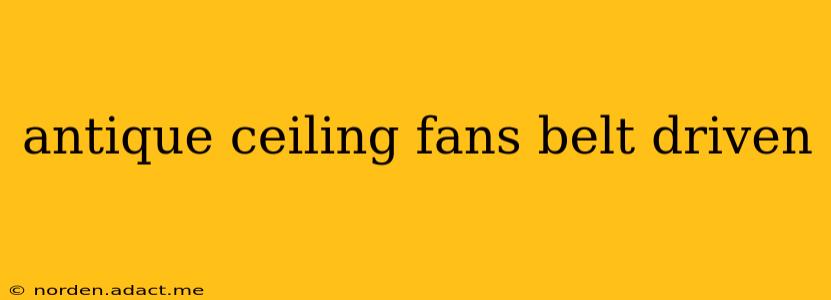Antique ceiling fans, particularly those with belt-driven mechanisms, possess a unique charm and historical significance. These aren't just functional appliances; they're captivating pieces of art that can add character and elegance to any home. This guide delves into the intricacies of antique belt-driven ceiling fans, exploring their history, restoration, and the special care they require.
What Makes a Ceiling Fan "Antique"?
Before we dive into belt-driven mechanisms, let's define what constitutes an antique ceiling fan. Generally, a ceiling fan is considered antique if it's at least 50 years old. However, fans from the late 19th and early 20th centuries are particularly prized for their craftsmanship and unique designs. These often feature intricate metalwork, decorative blades, and, frequently, a belt-drive system.
How Do Belt-Driven Antique Ceiling Fans Work?
Unlike modern ceiling fans which typically utilize direct-drive motors, belt-driven models use a system of belts and pulleys to transmit power from the motor to the fan blades. The motor, often located in the fan's housing, is connected to a pulley system that drives a second, larger pulley attached to the fan's blade assembly. This system allows for a quieter operation compared to some early direct-drive motors and also enables the use of larger, heavier blades.
What are the Advantages of Belt-Driven Antique Ceiling Fans?
While less common today, belt-driven antique ceiling fans offer several advantages:
- Quiet Operation: The belt system often results in a smoother, quieter operation than some early direct-drive motors.
- Aesthetic Appeal: The exposed mechanics of a belt-driven system can be a striking design element, adding to the fan's antique charm.
- Higher Torque: The system can provide greater torque, allowing for the use of larger, heavier blades.
What are the Disadvantages of Belt-Driven Antique Ceiling Fans?
Despite their charm, belt-driven fans do have some drawbacks:
- Maintenance: Belts can wear out and require replacement. Finding replacement belts for antique fans can sometimes be challenging.
- Efficiency: Belt-driven systems may not be as energy-efficient as modern direct-drive motors.
- Safety Concerns: Older wiring and components might pose safety risks if not properly inspected and repaired by a qualified electrician.
How to Identify an Antique Belt-Driven Ceiling Fan?
Identifying a genuine antique belt-driven fan requires a keen eye. Look for the following features:
- Exposed Belt and Pulley System: The most obvious indicator is the visible belt and pulleys connecting the motor to the blades.
- Ornate Design Elements: Antique fans often feature intricate metalwork, decorative blades, and unique housing designs.
- Manufacturer's Markings: Examine the fan for manufacturer markings or labels that can help date and identify it.
- Material Construction: Note the materials used in construction; brass, cast iron, and wood were commonly used in older fans.
Where Can I Find Parts for My Antique Belt-Driven Ceiling Fan?
Finding replacement parts for antique ceiling fans can be a challenge, but not impossible. You can try:
- Online Auction Sites: Websites like eBay often have listings for antique fan parts.
- Antique Shops and Flea Markets: These are good places to find both complete fans and individual parts.
- Specialty Fan Repair Shops: Some specialized repair shops may carry parts or have access to sources for rare components.
How Do I Restore My Antique Belt-Driven Ceiling Fan?
Restoring an antique ceiling fan is a labor of love, requiring patience and potentially specialized skills. Here's a brief overview:
- Safety First: Always disconnect the power before attempting any repairs. If you are not comfortable working with electrical components, hire a qualified electrician.
- Cleaning: Gently clean the fan blades and housing, using appropriate cleaning solutions.
- Belt Replacement: If the belt is worn or broken, replace it with a compatible belt (finding the right size might require some research).
- Motor Inspection: Check the motor for any damage or signs of wear. A qualified electrician should inspect and repair any electrical issues.
- Blade Balance: Ensure the blades are balanced to prevent wobbling.
Are Antique Belt-Driven Ceiling Fans Safe to Use?
While antique belt-driven ceiling fans can be beautiful and functional, their safety depends heavily on their condition and proper restoration. It's crucial to have a qualified electrician inspect the wiring and motor before using an antique fan. Improperly maintained fans can pose fire or electrical shock hazards. Never operate a fan that shows signs of damage or malfunction.
This guide provides a starting point for understanding and appreciating antique belt-driven ceiling fans. Remember, these are valuable historical artifacts that deserve proper care and attention. With careful restoration and maintenance, they can continue to add beauty and charm to your home for generations to come.
